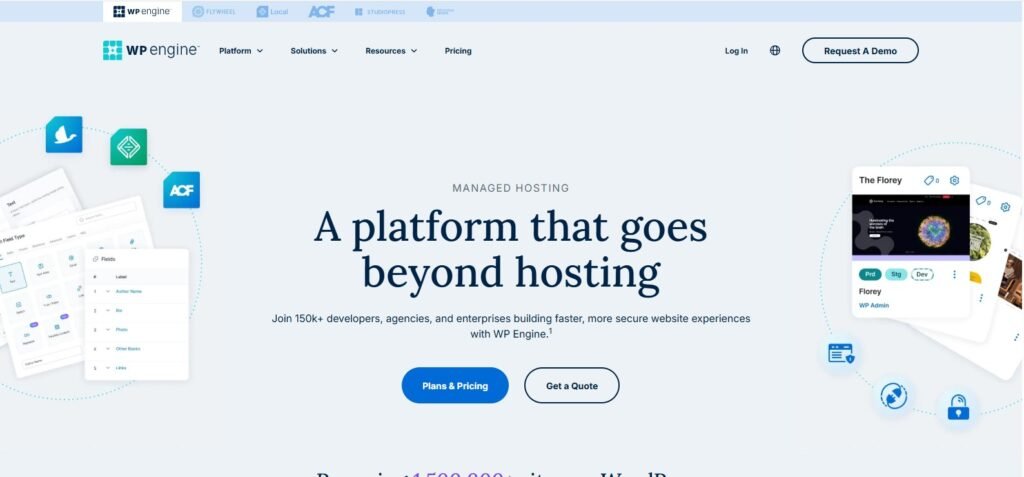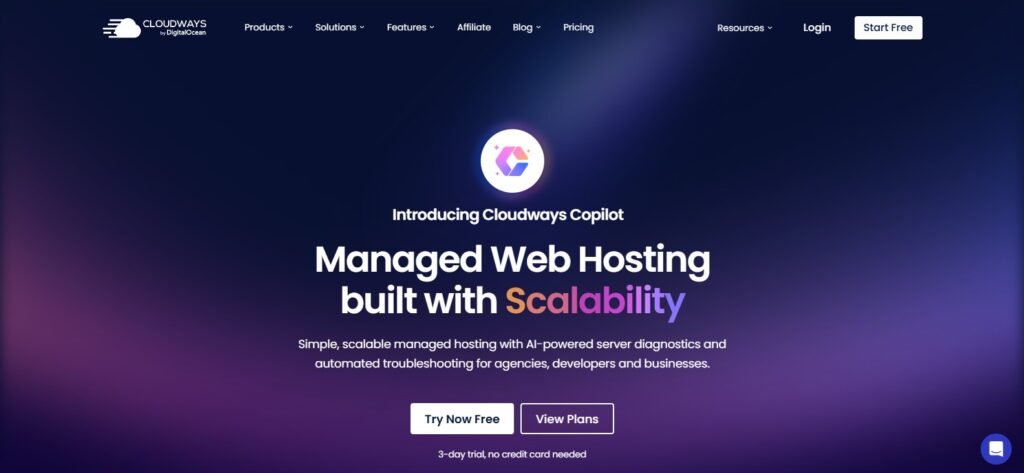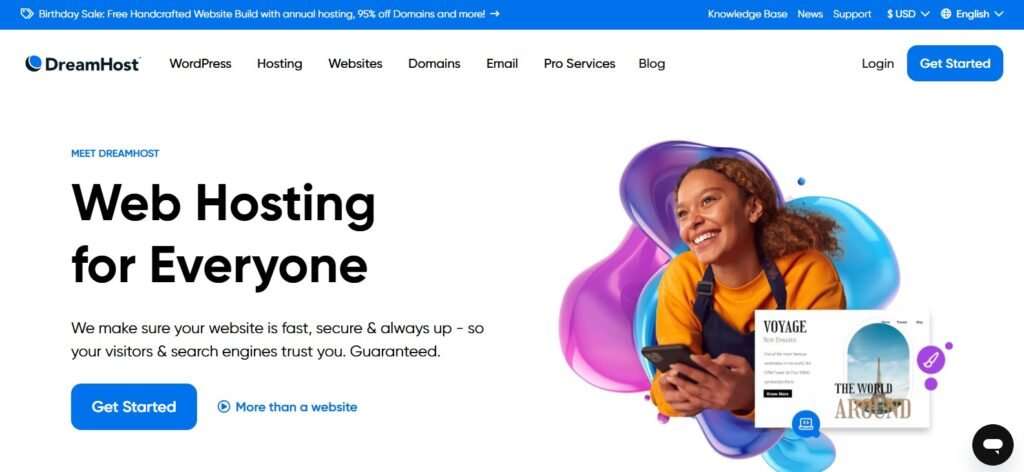Last Updated on November 2, 2025
WordPress Multisite is a powerful feature that lets you run multiple websites from a single installation. It’s perfect for agencies, universities, franchises, or content networks managing dozens—or even hundreds—of sites.
But here’s the problem: when you share one database and one codebase, even a small mistake (like a plugin update or PHP tweak) can break every site in your network.
That’s why every serious developer uses a staging environment—a safe, private clone of your website where you can test updates, design changes, or new code without putting live sites at risk.
In 2025, several hosting companies offer free staging environments built right into their WordPress plans—saving you from the complexity of manual setup. Let’s explore why staging is essential and which hosts offer the best solutions for WordPress Multisite users.
What Is a Staging Environment (and How It Works for Multisite)?
A staging environment is a private duplicate of your live site. It runs on the same server configuration but uses a separate URL (e.g., staging.yourdomain.com).
How It Works for Regular WordPress Sites:
- You click “Create Staging” → host clones your database + files.
- You make edits or updates in staging.
- Once satisfied, you “Push to Live.”
- The changes overwrite your live site.
How It Works for WordPress Multisite:
For multisite, it’s more complex because all sites share:
- One WordPress core installation
- One shared
wp_userstable - Dozens (or hundreds) of unique sub-site tables
A true staging solution for multisite must:
- Clone the entire network (not just a sub-site)
- Maintain database relationships
- Handle domain mapping (subdomain/subdirectory)
- Allow full rollback in case of failure
That’s why only a handful of premium hosts provide native multisite staging that works reliably out of the box.
Why Staging Is Critical for WordPress Multisite Users
| Problem | Risk Without Staging | How Staging Solves It |
|---|---|---|
| Plugin update breaks the theme | All sub-sites crash | Test first in staging |
| Theme customization gone wrong | Affects all users | Rollback instantly |
| PHP version upgrade fails | Fatal errors sitewide | Validate in staging |
| Database migration errors | Data corruption | Safe preview of DB sync |
| Client edits on live site | SEO or design impact | Safe sandbox for edits |
If you manage multiple clients, staging isn’t optional—it’s the lifeline between safety and chaos.
Key Hosting Features You Need for WordPress Multisite
- Free One-Click Staging – Instantly clone your full network.
- Push/Pull Deployment – Sync changes between staging and live environments.
- Multisite Compatibility – Full support for subdirectory and subdomain setups.
- Scalable Infrastructure – Add CPU/RAM easily as network grows.
- Automated Backups – Daily restore points for rollback.
- Free SSL + CDN Integration – Essential for security and speed across subsites.
- PHP Workers and Object Cache (Redis) – Prevents slowdowns during high activity.
- Staging Security – Password-protected and search engine–blocked.
Top Hosting Providers with Free Staging for WordPress Multisite (2025)
Below is an in-depth look at the best hosts that combine performance, safety, and ease of use.
1. SiteGround – Best All-Around Choice for Multisite Staging

Overview:
SiteGround is a veteran in managed WordPress hosting, famous for its free staging feature, stellar support, and fast cloud infrastructure.
Key Features:
- Free staging tool (GrowBig & GoGeek plans)
- Full multisite support (subdomain or subdirectory)
- Git version control built-in
- Dynamic caching + Cloudflare CDN
- Automated daily backups
Why It’s Great:
SiteGround’s staging tool allows granular push options (database only, files only, or both). It creates a full multisite clone with a single click. You can then merge changes selectively—a lifesaver for developers.
Tech Stack: PHP 8.3, MySQL 8, NGINX reverse proxy, SSD storage
💰 Starting Price: $4.99/month
🌍 Best For: Agencies and freelancers managing multiple small networks
2. Kinsta – Enterprise-Level Staging on Google Cloud

Overview:
Kinsta offers enterprise-grade hosting powered by Google Cloud C2 virtual machines, ensuring maximum speed and scalability. Each site gets an isolated environment with staging pre-installed.
Key Features:
- Unlimited free staging environments
- Full support for WordPress Multisite
- Redis, Nginx, and MariaDB 10.11 stack
- Edge caching (Cloudflare Enterprise)
- Automatic daily & on-demand backups
Why It’s Great:
Unlike traditional shared hosting, Kinsta isolates every WordPress site inside a container. This isolation prevents one multisite instance from affecting another. You can create two-stage environments—one for development and one for staging—before going live.
💰 Starting Price: $35/month
🌍 Best For: Large networks, universities, enterprise-grade websites
3. WP Engine – Pro-Level Dev/Staging/Live Workflow

Overview:
WP Engine is built for professional WordPress development. It automatically provides three environments: Dev, Staging, and Production.
Key Features:
- Free staging for all sites (including multisite)
- Git integration + SSH access
- Automated plugin/theme updates
- Redis + EverCache performance layer
- 24/7 expert WordPress support
Why It’s Great:
WP Engine’s “copy environment” feature lets you clone staging to development or push staging to production seamlessly. It’s ideal for high-traffic multisites with frequent code releases.
💰 Starting Price: $20/month
🌍 Best For: Developers managing active, update-heavy networks
4. Cloudways – Flexible Cloud Hosting with One-Click Staging

Overview:
Cloudways offers managed cloud servers from providers like DigitalOcean, Vultr, Linode, AWS, and Google Cloud.
Their one-click staging system works beautifully with WordPress Multisite, letting you test code in isolation.
Key Features:
- Free staging and cloning
- Redis & Varnish caching
- Pay-as-you-go pricing
- Team collaboration and staging sync
- Free SSL and backups
Why It’s Great:
Cloudways is perfect for developers who want full control. You can spin up staging on the same server or deploy it to a different provider entirely—ideal for multisite development teams.
💰 Starting Price: $14/month
🌍 Best For: Developers needing flexibility and multi-cloud setups
5. Hostinger Cloud – Affordable Staging for Growing Networks
Overview:
Hostinger’s Cloud Business plan delivers top-tier performance at a fraction of managed host prices. Its staging tool works even with WordPress Multisite networks.
Key Features:
- One-click staging & restore
- NVMe SSD + LiteSpeed Cache
- Free domain, SSL, and CDN
- PHP 8.3 + isolated resources
- Daily backups
Why It’s Great:
A perfect fit for small-to-medium multisite setups that need staging but can’t afford enterprise hosting. Hostinger’s UI makes staging incredibly simple.
💰 Starting Price: $9.99/month
🌍 Best For: Agencies on a budget
6. A2 Hosting Turbo – Developer-Oriented Performance
Overview:
A2 Hosting is well-known for performance. While its staging feature is manual (via Softaculous), it supports Multisite and full SSH access.
Key Features:
- NVMe SSD + LiteSpeed servers
- Free site cloning and staging in cPanel
- Redis + Opcache ready
- Developer access (SSH, Git)
- Free SSL and CDN
Why It’s Great:
For developers who prefer control, A2 lets you manage your own staging directory and database copy easily. The LiteSpeed + Redis combo keeps even large networks fast.
💰 Starting Price: $7.99/month
🌍 Best For: Technical users managing mid-size multisites
7. DreamHost DreamPress – Reliable & Unlimited

Overview:
DreamHost’s DreamPress is a managed WordPress platform that includes unlimited bandwidth and free staging.
Key Features:
- Free one-click staging
- Unlimited storage and bandwidth
- Built-in caching
- 97-day money-back guarantee
- Multisite supported on higher plans
Why It’s Great:
DreamPress focuses on simplicity—great for creators who want staging without complex tools. The unlimited resources make it suitable for content-heavy multisites.
💰 Starting Price: $16.95/month
🌍 Best For: Content publishers and educators
Performance Comparison Table (2025)
| Provider | Staging | Multisite Support | Cache System | Uptime | Price (USD) |
|---|---|---|---|---|---|
| SiteGround | ✅ Yes | ✅ Full | Dynamic + NGINX | 99.9% | 4.99 |
| Kinsta | ✅ Yes | ✅ Full | Redis + Edge Cache | 99.99% | 35 |
| WP Engine | ✅ Yes | ✅ Full | EverCache + Redis | 99.99% | 20 |
| Cloudways | ✅ Yes | ✅ Full | Redis + Varnish | 99.95% | 14 |
| Hostinger | ✅ Yes | ✅ Partial | LiteSpeed | 99.9% | 9.99 |
| A2 Hosting | ✅ Manual | ✅ Yes | LiteSpeed + Opcache | 99.9% | 7.99 |
| DreamHost | ✅ Yes | ✅ Yes | Built-in Cache | 99.9% | 16.95 |
Developer Guide: How to Use Staging with WordPress Multisite
Even with built-in tools, understanding the workflow helps you avoid conflicts.
Step 1 – Create the Staging Copy
Most hosts offer a “Create Staging” button. For manual setup:
- Clone files using SSH:
rsync -avz public_html/ staging.yourdomain.com/ - Export the database with
mysqldump. - Update the site URLs in the cloned database (use WP-CLI or search-replace plugin).
Step 2 – Configure Staging for Multisite
In wp-config.php, define:
define('MULTISITE', true);
define('SUBDOMAIN_INSTALL', true);
define('DOMAIN_CURRENT_SITE', 'staging.yourdomain.com');
define('PATH_CURRENT_SITE', '/');
This ensures proper mapping for sub-sites during staging.
Step 3 – Test Updates Safely
- Update themes/plugins
- Run compatibility checks for PHP versions
- Test login/logout across all sub-sites
- Verify performance and caching
Step 4 – Push to Production
Hosts like SiteGround, WP Engine, or Kinsta let you push selectively:
- Files only (theme changes)
- Database only (content updates)
- Both (major releases)
Always trigger automatic backup before pushing.
Advanced Staging Techniques for Agencies
1. Multi-Level Environments
Use three environments:
- Development (local coding)
- Staging (final testing)
- Production (live)
2. CI/CD Integration
Connect staging with GitHub or GitLab using webhook automation.
For example, commit to main branch → host automatically deploys to staging.
3. Database Sync Automation
Plugins like WP Migrate DB Pro or host-native tools (Kinsta, WP Engine) allow selective data synchronization between environments.
4. CDN Edge Testing
Enable CDN on staging to see how sub-sites perform globally before launch.
Common Staging Mistakes to Avoid
- Indexing staging sites: Always use
noindexto block Google. - Pushing test data live: Exclude temporary posts and dummy users.
- Overwriting production DB accidentally: Always backup first.
- Not testing plugin conflicts: Run updates one at a time.
- Ignoring PHP workers: Multisite needs at least 4–8 workers for concurrency.
Recommended Hosting by Use Case
| Use Case | Recommended Host | Why |
|---|---|---|
| Best Overall | SiteGround | Affordable, stable, multisite-compatible |
| Enterprise/Corporate | Kinsta | Google Cloud infrastructure, isolated staging |
| Developer Workflow | WP Engine | 3-tier environments, Git integration |
| Custom Setup Control | Cloudways | Multi-cloud, manual staging flexibility |
| Budget Option | Hostinger Cloud | NVMe storage, free domain, low cost |
| Unlimited Resources | DreamPress | No bandwidth or storage limits |
| Manual Power Users | A2 Hosting | Full SSH and custom staging setup |
FAQs: Staging Environments and WordPress Multisite
Q1. Does every hosting provider support WordPress Multisite?
No. Many disable it on shared plans. Always check the documentation before activating Multisite.
Q2. Can I create a staging site for just one sub-site?
Typically, no. Most hosts clone the entire Multisite. However, Cloudways and A2 Hosting let developers stage partial sites manually.
Q3. Will staging affect SEO or analytics?
No, staging sites are usually password-protected and marked noindex. They are invisible to search engines.
Q4. Can staging slow down my server?
Only if it’s hosted on the same resources. Premium hosts isolate staging on separate containers.
Q5. What’s the safest way to push updates to live?
Always backup first, push in low-traffic hours, and verify database merges. Use Git-based deployment if possible.
Q6. Is staging included in free hosting?
No. It requires extra server resources and is available only in paid plans.
Q7. What if my staging site gets stuck or corrupted?
Simply delete and recreate it. Hosts like Kinsta, WP Engine, and SiteGround let you rebuild staging in one click.
Conclusion
A free staging environment is the cornerstone of professional WordPress Multisite hosting. It lets you test updates, deploy confidently, and protect your live network from catastrophic errors.
In 2025, the best hosting providers offering free, multisite-compatible staging are:
- SiteGround — best overall value for most users
- Kinsta — best enterprise-grade performance
- WP Engine — perfect for developer workflows
- Cloudways — great for technical flexibility
- Hostinger Cloud — strong budget-friendly option
- DreamPress — unlimited storage simplicity
If you manage multiple websites under one network, staging isn’t optional — it’s your safety net.
Invest in hosting that provides it for free, and you’ll never fear an update again.



